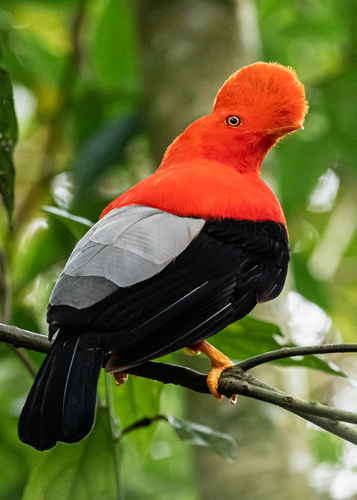
Andean Cock-of-the-rock
The Andean Cock-of-the-rock (*Rupicola peruvianus*) is a striking and iconic bird species native to the Andean cloud forests of South America. Renowned for its vibrant plumage and elaborate courtship displays, it plays a crucial role in its ecosystem as a seed disperser. This species holds cultural significance for many indigenous communities, often appearing in folklore and art. Its presence is a strong indicator of a healthy, intact cloud forest environment.
30-32 cm
Length
Not Evaluated cm
Wingspan
Least Concern
Conservation Status
Distribution
The Andean Cock-of-the-rock is found along the Andes Mountains, spanning Venezuela, Colombia, Ecuador, Peru, and Bolivia. It primarily inhabits humid and subtropical montane forests, typically at elevations between 500 and 2,400 meters (1,600 to 7,900 feet).
Lifespan
Unknown in the wild, but estimated to be around 7 years based on related species.
Andean Cock-of-the-rock's Habitat
Habitat Types
Cloud forests, Montane forests, Rocky areas near streams
Climate Zones
Tropical, Subtropical
Adaptations
Their strong legs and feet are well-suited for navigating the steep, rocky terrain of their cloud forest habitat. They prefer areas with dense vegetation and proximity to water sources.
Variations
Several subspecies are recognized, differing slightly in plumage coloration and distribution. For example, *R. p. sanguinolentus* is found in the western Andes of Colombia and Ecuador.
Appearance
Breeding Plumage
Males have brilliant orange or red plumage year-round. Females are a duller brownish-orange, providing better camouflage for nesting.
Seasonal Feather Changes
Minimal seasonal variation, primarily related to feather wear and molt.
Sex Based Plumage Differences
Highly pronounced. Males are bright orange or red with a prominent crest, black wings, and a black tail. Females are predominantly brownish-orange with a smaller crest.
Notable Features
Large, fan-shaped crest that almost completely covers the bill in males., Bright orange or red coloration in males., Strong legs and feet.
Diet and Feeding
Primary Foods
Fruits, Insects, Small vertebrates (occasionally)
Foraging Behavior
Primarily frugivorous, foraging in the forest canopy and understory. They pluck fruits while perched or during short flights. Insects are also gleaned from foliage.
Specializations
Their relatively broad gape allows them to swallow large fruits whole, aiding in seed dispersal.
Seasonal Diet Variations
Diet may shift slightly depending on fruit availability throughout the year. During periods of fruit scarcity, they may consume more insects.
Behavior
Social Structure
Males are polygynous and gather in leks for display. Females are more solitary, especially during nesting.
Communication
Loud, raucous calls, especially during lek displays., Visual displays, including wing flapping and bowing., Cawing and clicking sounds.
Migration
Generally non-migratory, but may make local altitudinal movements in response to fruit availability.
Territorial or Group Behaviors
Males defend small display territories within the lek. Females do not appear to be territorial.
Conservation
Threats
Habitat destruction (deforestation for agriculture and logging), Habitat fragmentation, Hunting (in some areas)
Protection Programs
Protected areas within their range (national parks and reserves), Community-based conservation initiatives
Local National Laws
Protected under national laws in several countries within its range.
Population Trend
Decreasing
Population Estimates
Although classified as Least Concern, the global population is suspected to be declining due to habitat loss.
Interesting Facts
The male's crest is so large it almost completely hides its bill.
This impressive crest is crucial for attracting females during courtship displays.
They are known as "Gallito de las Rocas" in Spanish, which translates to "Little Rooster of the Rocks."
This name reflects their rooster-like appearance and their preference for rocky habitats.
The Andean Cock-of-the-rock is the national bird of Peru.
It is a symbol of the country's rich biodiversity and the importance of cloud forest conservation.
Faqs about Andean Cock-of-the-rock
What is a lek?
A lek is a gathering of males of certain animal species for the purposes of competitive mating display. Females visit the lek to choose a mate.
Why are the males so brightly colored?
The bright coloration is a result of sexual selection. Females prefer males with the brightest and most elaborate plumage, indicating good genes and health.
Are they endangered?
They are currently classified as Least Concern by the IUCN, but their populations are declining due to habitat loss. Continued deforestation could lead to a higher threat status in the future.
Copyright @ Nature Style Limited. All Rights Reserved.
 English
English